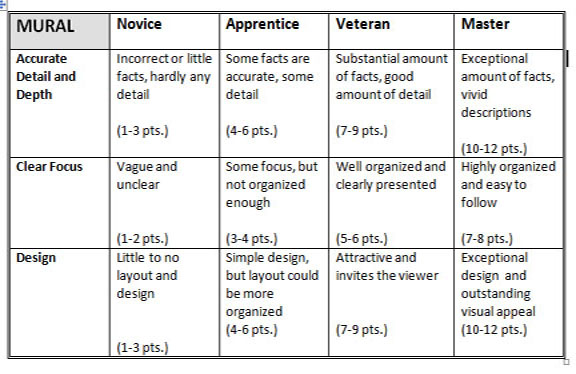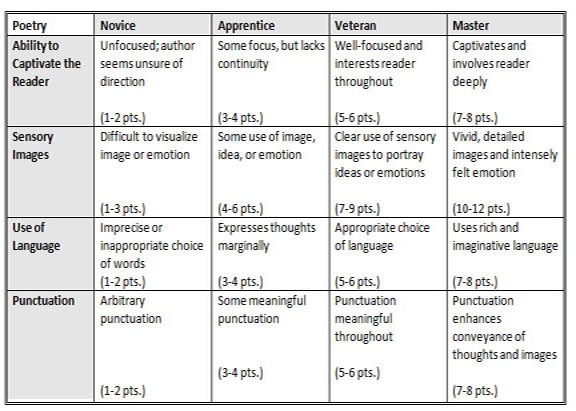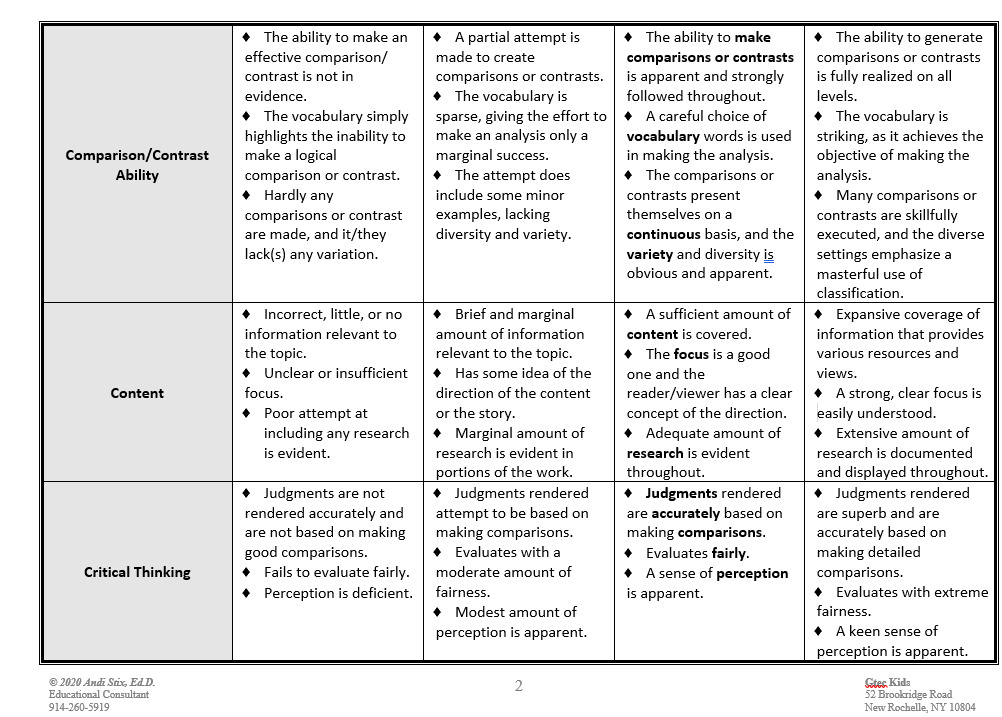Creating Rubrics Through Negotiable Contracting and Assessment

What would happen if students were invited to help decide how their work should be evaluated? Would they exploit the opportunity, designing standards so ridiculously low as to guarantee a glut of effortless good grades?
Surprisingly, the answer is no. Experience in Mrs. Martha Polin’s class at Robert Wagner Middle School in Manhattan shows that students who are given a role in the assessment process of a mural from a historical novel lesson can and do rise to the occasion. Given the appropriate direction by their teacher, youngsters are able to accurately evaluate their strengths and weaknesses and pinpoint where to focus their efforts to get the most out of what they’re learning. As a result, students view assessment not as an arbitrary form of reward or humiliation (a common perception of middle school students), but as a positive tool for personal growth.
This article examines “negotiable contracting,” a new approach to involving students in the assessment process that currently is being implemented in some schools in the New York City area. Negotiable contracting is adaptable to both arts and science curriculum and is flexible enough to accommodate multi-modal forms of learning. Like any assessment, it ensures that the teacher remains squarely in charge of the classroom and, ultimately, responsible for assuring that grading is appropriate.
Empowering Students
The art of negotiable contracting consists of giving students shared ownership in their own learning (Wiggins 1993). Although he is ultimately responsible for grading, the teacher functions not as an all-powerful judge of students’ work but as a facilitator of discussion on the assessment process (Seeley 1994). Before the teacher presents his or her own expectations of the work, (s)he asks students their opinion of what they think would constitute quality work. Across the “negotiating table,” teacher and class arrive at a consensus that is mutually acceptable. The result is that students feel like valued participants in the assessment process. Thus, they are motivated to strive toward those criteria-based standards.
The contract process can be used independently of a formal evaluation and can serve a variety of purposes. Some lessons do not call for formal assessment. However, the teacher still wants to set short-term goals by establishing criteria for high-quality work. Negotiable contracting is ideal for such a lesson. For example, if students are to work together in groups, negotiable contracting is helpful in setting up expectations such as cooperative roles, research materials, and formats for charts and graphs.
Creating the Rubric
 The rubric is an important element of using negotiable contracting for formal assessment. (Pate, Homestead, and McGinnis 1993). Creating rubrics is a rating chart that is drawn up jointly by teacher and students. Along one side of the rubric are listed the criteria that the teacher and students decide are the most important ideas to be mastered in the lesson. Across the top of the rubric are listed the rankings that will be used to assess how well students understand each of those criteria. The rubric also indicates how much importance should be given to each criterion, based on its importance to the overall lesson. Within each ranking, there also may be numerical gradations, depending on whether a student performs on the higher or lower level of that category. Unlike a traditionally assigned, generalized number or letter grade, the rubric serves as an in-depth “report card” for a lesson, unit, or project.
The rubric is an important element of using negotiable contracting for formal assessment. (Pate, Homestead, and McGinnis 1993). Creating rubrics is a rating chart that is drawn up jointly by teacher and students. Along one side of the rubric are listed the criteria that the teacher and students decide are the most important ideas to be mastered in the lesson. Across the top of the rubric are listed the rankings that will be used to assess how well students understand each of those criteria. The rubric also indicates how much importance should be given to each criterion, based on its importance to the overall lesson. Within each ranking, there also may be numerical gradations, depending on whether a student performs on the higher or lower level of that category. Unlike a traditionally assigned, generalized number or letter grade, the rubric serves as an in-depth “report card” for a lesson, unit, or project.
Mrs. Martha Polin assigned her students the task of creating a mural along with an explanation from a historical novel that they read. Before they began any work on the murals, she arranged the class in cooperative learning groups and asked them to consider, “If you were me, what qualities would you look for in deciding how to grade each mural? Come up with six criteria that you would look for.” After allowing time for discussion, Mrs. Polin asked each group to rank the qualities they had selected in order of importance, from most important to least important.
Next, each group presented its top two criteria to the class. Mrs. Polin listed those criteria on the board and the class was asked to choose which ones were truly most relevant to the lesson. With the teacher’s guidance, they agreed on three qualities: 1) detail and depth; 2) a clear focal point; and 3) a high-quality design. They then were asked, “What should be considered ‘poor,’ ‘fair,’ ‘good’ and ‘excellent’ performance for each criterion?” One student suggests that a poor mural would have most of the facts wrong, and the other students readily agree. “What about if only some of the facts are wrong?” Mrs. Polin asks. “That would be a fair grade,” says one boy. “I think having some of the facts wrong should still be a poor grade,” argued another student. Finally, after some more discussion, a consensus is reached among the class that getting only some of the facts wrong would earn a “fair” grade. After more discussion, they also decide that getting all the facts right should earn a “good” grade while getting an exceptional amount of accurate, interesting information from unusual sources would earn a rating of excellent.
As a result of their negotiations, before they’ve even picked up a pencil or pen, Mrs. Polin’s students are perfectly clear about what is expected in their murals. Moreover, they have the satisfaction of having had a voice in setting the objectives for the project and establishing a rating system that they consider to be fair.
| Criteria: |
| Accurate Detail |
and Depth Clear Focal Point High – Quality Design
The next step in creating a rubric is to negotiate ratings to reflect how well each of these criteria is met. Across the top of the rubrics’ chart are listed the various rankings, in lieu of grades or numbers. Again, those rankings may be decided during negotiations between teacher and class. There is a separate rating for each of the criteria in the rubric since students naturally will be stronger in some aspects of their work than in others.
Choosing neutral words for each rating avoids the implication of good/bad inherent in a generalized A-F or numerical grade. In addition, the natural temptation of instructors — as well as students — to award a middle-ranking is avoided by the use of an even number of rankings. For example, in a 1-5 ranking system, 3 tends to be used as a “neutral” grade.
| Attempted | Acceptable | Admirable | Awesome |
| Glass | Garnet | Ruby | Diamond |
| Lead | Bronze | Silver | Gold |
| Larvae | Pupa | Cocoon | Butterfly |
| Peasant | Artisan | Noble | Pharaoh |
| Freshman | Sophomore | Junior | Senior |
| Page | Squire | Knight | Lord |
| Sour Milk | Milk | Half and Half | Cream |
| Jeans | Sport Jacket | Suit | Black Tie |
| Amateur | College Athlete | Semi-Professional | Professional |
| Byte | Kilobyte | Megabyte | Gigabyte |
| Private | Sergeant | Lieutenant | Captain |
| Pepper | Cinnamon | Nutmeg | Saffron |
| Ground Round | London Broil | Sirloin | Filet Mignon |
| Bob Cat | Panther | Tiger | Lion |
| Minnow | Flounder | Tuna | Shark |
| Weed | Daisy | Rose | Orchid |
| First Base | Second Base | Third Base | Home Plate |
| Penny | Quarter | Half Dollar | Silver Dollar |
| Garden | Rattle | Cobra | Python |
| Delta | Plain | Plateau | Mountain |
The State of Kentucky, which uses a rubric system of assessment, utilizes four non-pejorative ratings in its rubrics. In ascending order of competence, they are Novice, Apprentice, Proficient, and Distinguished:
| Novice | Apprentice | Proficient | Distinguished |
or
| Novice | Apprentice | Veteran | Master |
There is no “overall” rating for the child; the terms are used separately to evaluate students’ performance for each of the criteria in the rubric. For a social studies report, for examples, the ratings might be defined as follows:
- “Novice” is a student who has absorbed little of the lesson; it signals insufficient preparation, weak conclusions or organization, and incorrect information.
- “Apprentice” implies a beginning conceptual understanding; there is the main idea but it is presented only in broad outline with little detail and some erroneous or unclear information.
- “Proficient” signals a clear conceptual understanding of the lesson; the report was well organized, logical, and focused with few errors.
- “Distinguished” means outstanding work; work rich in-depth and precise detail with a consistent, powerful presentation and little to no errors.
It is useful to include numeral gradations within each category. For example, a student may receive an Apprentice rating of three or four, depending on whether he performs on a higher or lower end of that category.
Let’s examine how Mrs. Polin’s class created the rubric for their geography mural.

Creative Problem Solving
Rubrics can be especially effective in assessing student’s work in mathematics (Moon 1993). While rote skills such as memorizing the timetables may be best suited to traditional quizzing and grading, the majority of mathematics really involves creative problem solving in which there are several ways to arrive at a solution — some more succinct, effective, or creative than others.
For a lesson involving word problems in fractions, for example, the “report card” for students’ problem-solving might include an assessment criteria decided upon by teacher and students: Is the solution easy to follow? Does it demonstrate clear conceptual understanding? Would the answer work in real life? Do the diagrams, sentences, and numbers coordinate?
Similarly, rubrics can be used in any discipline-based or interdisciplinary lesson. The rubric can include opportunities for students to use journal work, projects, research studies, experiments, skits, or other vehicles to demonstrate their competence.
Good Poetry
Let’s look at how a rubric would be utilized in Mrs. Janine Bartko’s 8th grade Language Arts class, which is studying a unit on poetry. After discussing how poetry differs from prose and looking at various types of poetry, the students are given the assignment of writing a poem of their own. Mrs. Bartko then asks: “How can a poem– a subjective assignment with no ‘correct’ answer– be fairly assessed?”
The students launch into a discussion of what constitutes “good” poetry, as they were asked to write a piece reflecting a time in history. Working in groups, they come up with a rubric, composed of four main criteria that Mrs. Bartko and the students agree are the most appropriate and fair qualities. They decide a poem should portray emotion and/or imagery, captivate the reader, use language clearly, and use punctuation purposefully. Mrs. Bartko and her students then read various examples of how those skills are applied at the various rating levels. Finally, before filling in the rubrics with her students as a whole group, she asks the youngsters– sitting in cooperative workgroups — to try to evaluate the assignment and fill in the rubric on their own:

In addition to the rubric itself, there is an area included for comments. In this space, Mrs. Bartko can be even more specific about strengths and weaknesses and, accentuating the positive, suggest ways for each student to stretch his or her skills and expand his or her understanding. As a result, the rubric gives the student an overall picture of his or her skill level.
At Robert Wagner Middle School, some teachers have enlarged a blank rubric and laminated it. For each project, they use a dry erase marker and fill in the quadrants with the students. They do likewise with the assessment sheet. Students are each given a blank sheet and asked to fill it out with the teacher. Here, students have their own record of what is expected of them. At the end of the project, they may be asked to assess themselves and/or their peers and hand in the assessment sheet for the teacher to grade.
Recognizing Achievements
Rubrics thus offer an important way for educators to motivate students through assessment. Giving youngsters a voice in their grading provides them with a clear understanding of what is expected of them and the assurance that their accomplishments will be recognized.
© 1997 by Andi Stix, Ed.D.
Chapter 7 in Understanding Scoring Rubrics; A Teacher’s Guide, Carol Boston, EditorUS Department of Education ERIC #ED411274
For our readers: In what ways does allowing your students to have a voice in their own assessment empower and motivate them to achieve the task at a higher level? For what reasons does negotiable contracting encourage authenticity? In what ways can or can’t the criteria of assessment change between different classes, even though the objectives and goals may be the same? Compare and contrast the difference of when the assessment is authentic to the task vs. authentic to the needs of the students?
Andi Stix is an educational consultant & coach who specializes in differentiation, interactive learning, writing across the curriculum, classroom coaching, and gifted education. For further information on her specialties or social media, please email her on the Contact page.
References
Aschbacher, P. R. (1993). Issues in innovative assessment for classroom practice; Barriers and facilitators (Tech. Rep. No. 359)Los Angeles: University of California, CRESST; Center for the Study of Evaluation.
Feuer, M. J., & Fulton, K. (1993) The many faces of performance assessment. Phi Delta Kappan, 74:6, 478.
Jamentz, Kate. (3/94). Making sure that assessment improves performance. Educational Leadership. 51:6, pp. 57.
Levine, D. S. (1992). The four p’s of context-based assessment: Evaluating literacy across the curriculum. In C. Hedley, P. Antonacci, and D. Feldman (Eds.) Literacy across the curriculumNorwood, NJ: Ablex.
Meyer, Carol A. (1992) What’s the difference between authentic and performance assessment? Educational Leadership, 49:8, 39-40.
Moon, C. J. (1993). Connecting learning and teaching through assessment. Arithmetic Teacher, Vol. 41, No. 1, 13-15.
O’Neil, John (1992) Putting performance assessment to the test. Educational Leadership, 49:8, 14-19.
Pate, P. E., Homestead, E., McGinnis, K. (1993, November). Designing rubrics for authentic assessment. Middle School Journal.
Powell, Janet. (1993, November). What does it mean to have authentic assessment? Middle School Journal.
Seeley, Marcia M. (1994, October). The mismatch between assessment and grading. Educational Leadership. 52:2..
Simmons, W., & Resnick, L. (Feb. 1993) Assessment as the catalyst of school reform. Educational Leadership, 50:5, 11-15.
Tierney, R. J. (1992, September). Setting a new agenda for assessment. Learning. pp. 62-64.
Wiggins, Grant, (1993, November). Assessment: authenticity, context, and validity. Phi Delta Kappan, 75:3, p. 200-214.





